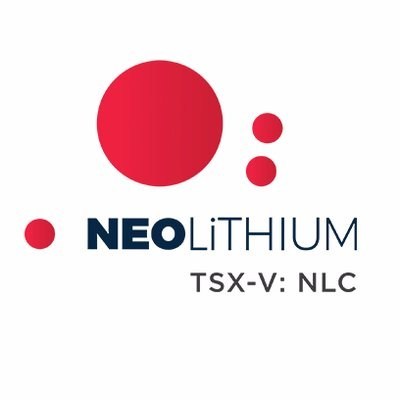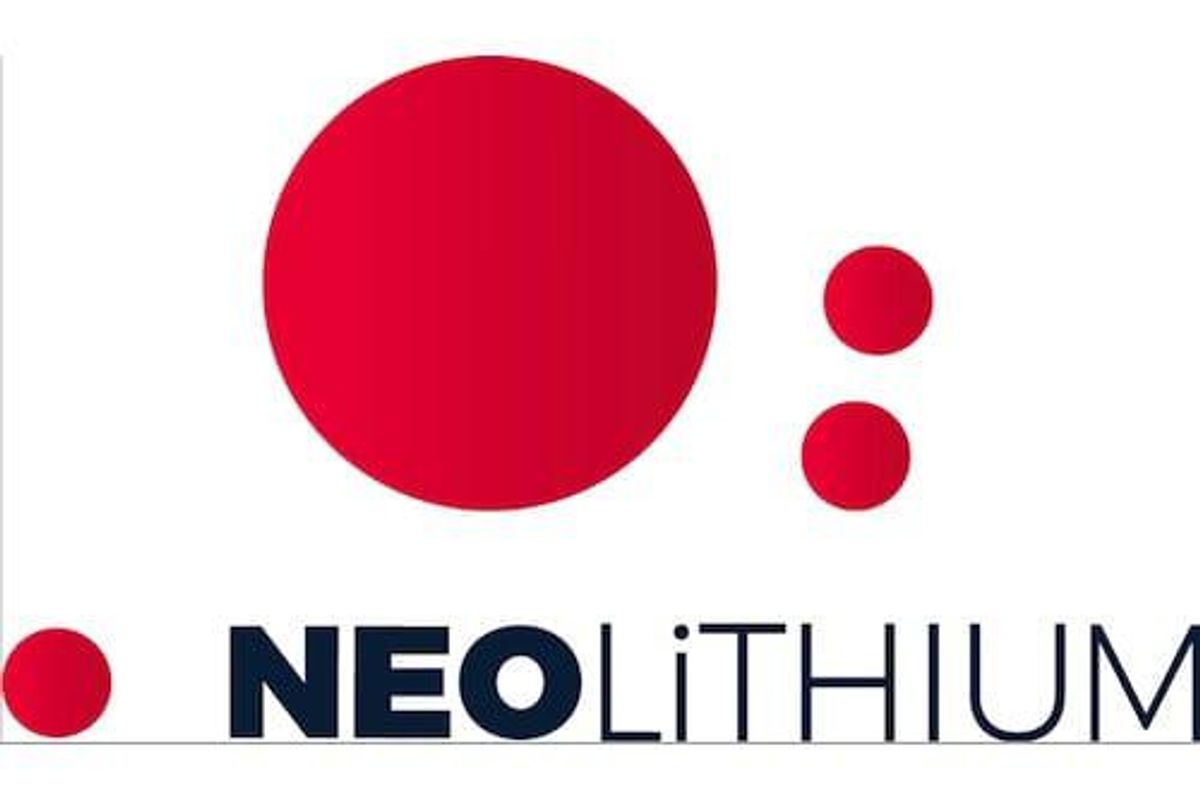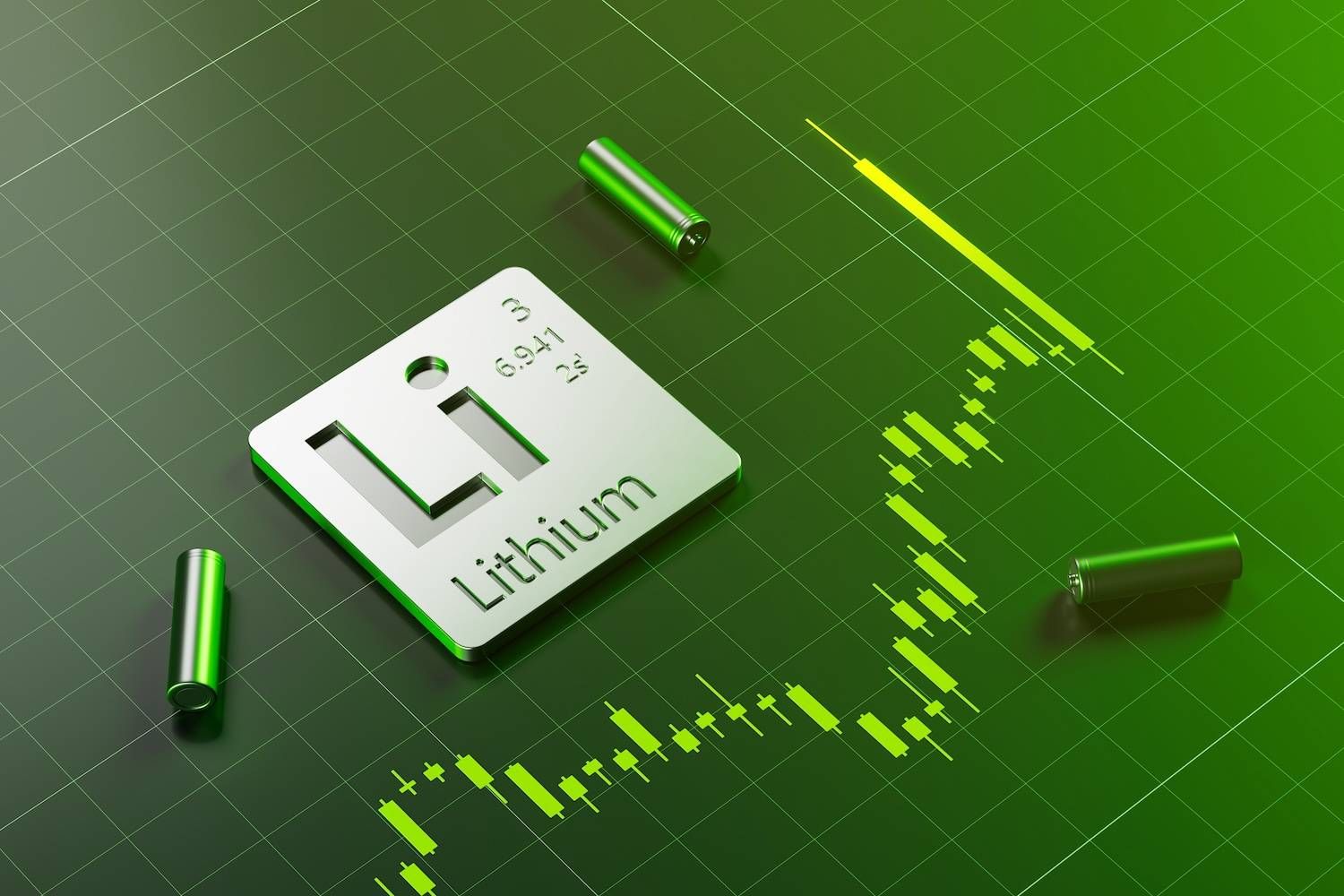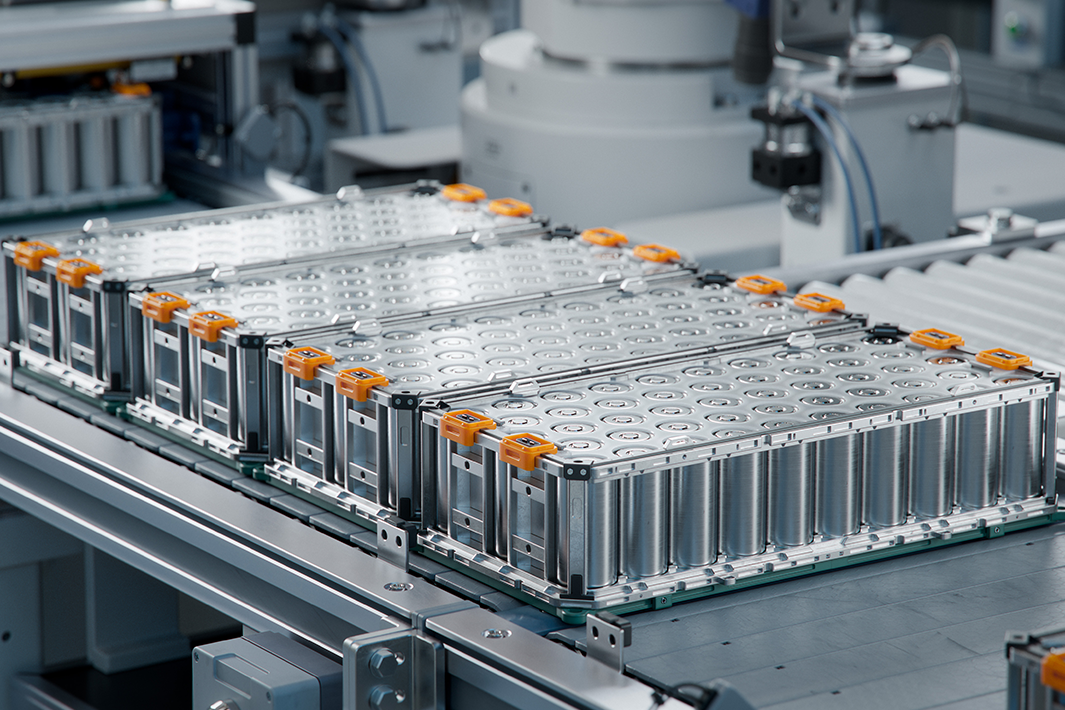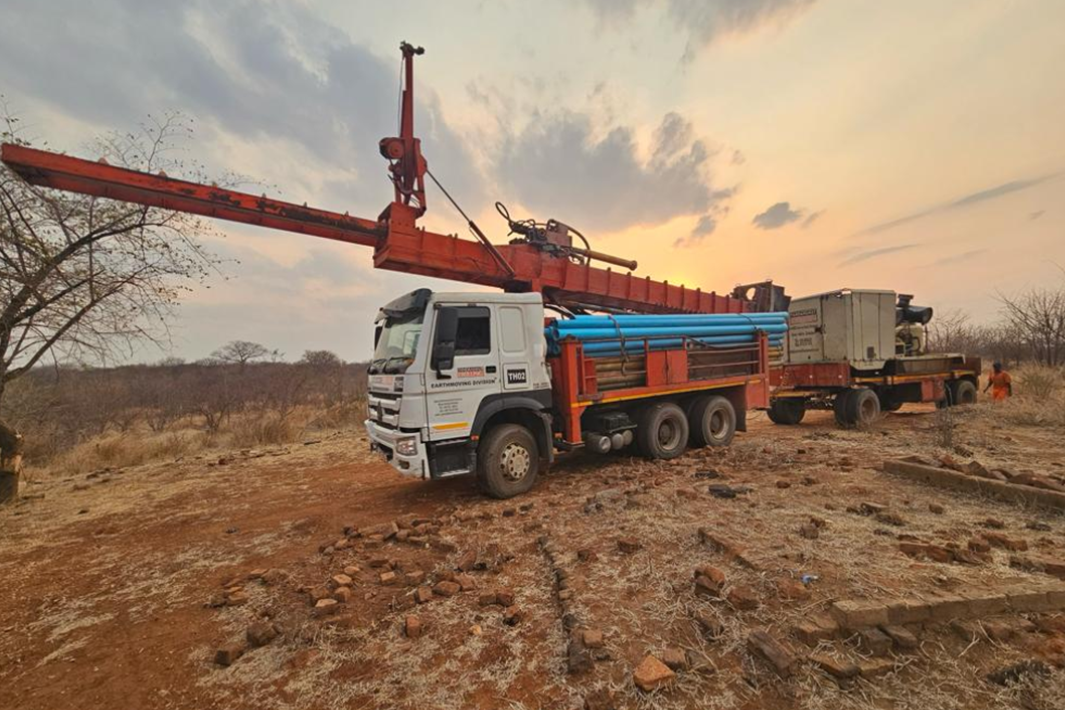
- Significant increase in northern high-grade mineral resource estimate at 800 mg/l lithium cut-off:
- Measured and indicated resource estimate of 1,682,000 tonnes of lithium carbonate equivalent at an average grade of 926 mg/l Lithium
- Significant increase of central and southern medium-grade resource estimate at 400 mg/l Lithium cut-off:
- Measured and indicated resource estimate 5,304,000 tonnes of lithium carbonate equivalent at an average grade of 636 mg/l Lithium
- Average combined impurities for Magnesium/Lithium and Sulphate/Lithium continue to be lowest in industry
- High grade resource with 800 mg/l cut off: Mg/Li=1.66 and Sulfate/Li=0.49
- Potential for resource expansion continues to exist at depth, and off strike on the eastern border of the 3Q Project under the alluvial cones.
Neo Lithium Corp. (" Neo Lithium " or the " Company ") (TSXV: NLC) (OTCQX: NTTHF) (FSE: NE2) is pleased to announce an updated resource estimate for the Tres Quebradas lithium brine project in Catamarca Province, Argentina (" 3Q Project "). This updated mineral resource estimate has been completed under the supervision of Canadian-based Groundwater Insight, Inc., which is independent of the Company.
Based on this updated mineral resource estimate, the 3Q Project deposit continues to improve, confirming that it is one of the largest and highest-grade lithium brine deposits in the world.
Since the completion of the previous mineral resource estimate in July 2018 , the Company has continued drilling and has revised the statistical criteria to define measured, indicated, and inferred resources. Using the new drill holes (see news release dated May 27, 2021 for further information) and the revised statistical criteria, the measured and indicated mineral resource categories have increased by 125% at the 800 mg/l lithium cut-off, and by 33% at 400 mg/l lithium cut-off, when compared to the July 2018 estimate. Similar average grades and impurities were observed.
The updated lithium resource estimate is summarized in Tables 1 and 2, for the 800 and 400 mg/l cut-offs, respectively, with comparison to the July 2018 results.
Table 1 - in situ Lithium Resource at 800 mg/L Lithium cut-off
| | Average | Brine Volume | Mass Cumulated | Comparison | |
| | Li (mg/l) | (Millions m³) | Li (tonne) | Li2CO3 | Li2CO3 (%) |
| Measured | 928 | 188 | 175,000 | 930,000 | 281% |
| Indicated | 923 | 153 | 141,000 | 752,000 | 50% |
| Total M & I | 926 | 341 | 316,000 | 1,682,000 | 125% |
| Inferred | 918 | 33 | 31,000 | 163,000 | -12% |
Table 2 - in situ Lithium Resource at 400 mg/l Lithium cut-off
| | Average | Brine Volume | Mass Cumulated | Comparison | |
| | Li (mg/l) | (Millions m³) | Li (tonne) | Li2CO3 | Li2CO3 (%) |
| Measured | 790 | 437 | 346,000 | 1,839,000 | 223% |
| Indicated | 576 | 1,131 | 651,000 | 3,465,000 | 1% |
| Total M & I | 636 | 1,568 | 996,000 | 5,304,000 | 33% |
| Inferred | 561 | 757 | 425,000 | 2,261,000 | -22% |
| Note: The tonnage values in Tables 1 and 2 are expressed as total contained metals and have been rounded to the nearest thousand. |
Average density for the brine is 1.217. The low magnesium and sulfate content of the mineral resource is consistent with the previous mineral resource estimate. Table 3 summarizes the main impurities ratios for magnesium and sulfate.
Table 3 - 3Q Project Impurity Ratios at 800 mg/l Lithium Cut-off
| Impurity Ratio | Magnesium/Lithium | Sulfate/Lithium | |
| | |||
| Measured | 1.66 | 0.49 | |
| Indicated | 1.66 | 0.48 | |
| Total M & I | 1.66 | 0.49 | |
| Inferred | 1.67 | 0.41 | |
"These updated results confirm that 3Q Project is one of the most significant lithium brine discoveries in recent history" said Dr. Perez, President and CEO of Neo Lithium . "We continue to add high quality resources to the 3Q Project and there is still incremental value and growth at this world-class high-grade resource."
Neo Lithium's wholly-owned 3Q Project is within an elongated salar, 28 km in length that contains a high-grade resource in the northern third of the salar, roughly defined by the 800 mg/l cut off, and a medium-grade resource in the southern two thirds of the salar, within the 400 mg/l cut off. The high-grade resource is strategically important because it requires smaller evaporation ponds to put the project into production. Since the pond size is geometrically related to grade, increases in grade have a significant impact in decreasing capital costs of pond construction. Ponds can represent up to 50% of the capital cost of an evaporative lithium brine project. Therefore, an important design goal of the project is to minimize pond size.
"We are very pleased with these updated results, which highlight further upside at the 3Q Project. However, this development does not take away focus from our ongoing work toward the completion of the Feasibility Study in Q3," said Gabriel Pindar, COO of Neo Lithium. " These results emphasize the potential for further expansion, even beyond what we originally thought."
Feasibility Study Update
The Company is working with Worley on the Feasibility Study for the 3Q Project. The current larger mineral resource estimate is not expected to negatively impact the new reserve estimation and mine plan that will be delivered as part of the Feasibility Study. The Company does not expect mineral extraction methods to change as a result of the increased mineral resource estimates, as the grade and location of the mineral resource remains substantially the same. Accordingly, the "Preliminary Feasibility Study ("PFS") - 3Q Project, NI 43-101 Technical Report Catamarca, Argentina " with an effective date of May 7, 2019 and amended as of May 8, 2019 , and subsequently amended April 1, 2021 is still relevant and valid as a preliminary indication of the economic potential of the 3Q Project.
A new reserve estimate will be issued along with the Feasibility Study, to be completed by Worley at the end of Q3 – beginning of Q4 2021. We have completed all base engineering work and issued proposals to receive vendor budgetary quotes to start compiling the Feasibility Study Capex estimate. At this stage we remain within the parameters of the PFS Capex and we do not expect major changes or deviations from it beyond the accuracy of the PFS estimate.
Our expanded pilot ponds have been commissioned and are fully operational. We will be reconfiguring the pilot plant to reflect continuous operation as part of our operational testing procedure. Both systems have provided valuable information in support of the Feasibility Study and are serving as training grounds for our team in Argentina . We are proud to announce that we have now reached 20% of our future permanent staff, in full compliance with our Environmental, Social and Governance (ESG) goals, providing training and work opportunities to local people, and thus strengthening the relationship with our local community.
Resource Estimate Methodology
The mineral resource estimate was prepared in accordance with best practice methods specific to brine resources. The approach includes a reliance on drilling and sampling methods that yield depth-specific chemistry and drainable porosity measurements of the brine host rock.
The mineral resource calculation is based on four drilling and sampling campaigns, which included the following:
- Completion of 10,523.65m of drilling ( 6,145.75m of diamond drill and 4,377.90m of rotary holes) divided in 56 drill holes.
- The deepest hole was 647m .
- The rotary wells were completed with 8 or 10 inch PVC or iron piping. They were pumped for over 48 hours to ensure the brine flowed from the aquifer and that all remaining traces of drill mud was removed. Outflow was typically sampled at six-hour intervals. All samples were averaged (typically 6 to 10 samples were collected in each well) and the sample concentration was attributed to the gravel pack interval of the well.
- The diamond drill holes were cored with HQ triple tube.
- Of the 56 holes used for the mineral resource estimate, nine reached the basement at depths ranging from 50m (in the western boundary of the salar) to 647m in the eastern border of the salar. All others were terminated after reaching target depth or due to drill limitations.
- The total thickness of the basin exceeds 650m on the eastern side, and brine saturated sediments are present throughout the majority of the sequence; the exception is relatively fresher-water zones where surface inflows occur.
- A total of 230 brine samples plus 74 QA/QC samples were collected from the drill holes during drilling and from completed wells; and 45 surface samples were collected from the 3Q and Verde lagunas. Repeat samples were averaged resulting in 184 unique sample locations, that were used to calculate the resource estimate.
- Brine samples were collected from the diamond drill holes during drilling, using a standard packer technique (both single and double packer) to obtain samples from discrete levels of the formation. Fluorescein dye was used to ensure that the samples were representative of the collection interval. Sampling intervals range from 2m to 50m , depending on the hole.
- Brine was sampled (and bathymetry conducted) in Laguna 3Q and Laguna Verde, located at the north and south ends of the salar, respectively. Extensive sampling indicates that the brine composition in these lagunas is essentially continuous with the brine under the salar crust.
- Brine samples interpreted to reflect the influence of freshwater inflows ( Rio Salado , Rio Nacimiento, and Rio 3Q) were removed from the data set prior to interpolation. Similarly, volumes of the subsurface associated with fresher water were also removed from the salar volume for resource estimation.
The previous (2018) mineral resource estimate used a search radius criteria technique to classify measured, indicated and inferred resources. In the current estimate the approach was revised to a borehole density method. Both methods are widely used in both brine and hard rock resource estimation. The borehole density method was considered more appropriate based on an increasing body of site data, which continue to support spatially predictable geology and brine trends.
Geology and Brine Model
Geology and brine models were assembled in the numerical modeling software FEFLOW. Geology was interpreted from surface mapping, diamond drilling core and rotary borehole logging. Eight primary geological units were identified:
- Brine lakes: standing bodies of surface brine at the north and south ends of the salar complex (Laguna 3Q and Laguna Verde, respectively);
- Hyper-Porous Halite: karstic, near surface halite (typically less than 50m depth);
- Upper Sediments: formed by sand, silt and conglomerates located at surface or near surface;
- Porous Halite: formed by halite with moderate porosity that is readily identified by visual methods;
- Massive Halite: this unit generally occurs as labelled, but often contains interbedded layers of clay, volcaniclastics, and halite with greater visible porosity. Consistent with this observation, a range of tests have indicated potentially important porosity in this unit.
- Lower Sediments: well rounded sand, silt and minor conglomerates hosted below the Massive Halite (typically 300m to 500 m deep);
- Fanglomerates: sedimentary polymictic angular breccia with sand matrix located below the Lower Sediments and above the Basement, typically below 500 m depth; and
- Hydrostratigraphic Basement: Permian andesites and dacites; generally considered to have negligible or low drainable porosity.
Core samples were packed in Lexan tubing and shipped to Daniel B. Stephens & Associates Inc. ("DBS"), Inc., a laboratory in the U.S., to measure Relative Brine Release Capacity (RBRC). This method of porosity determination is designed to estimate Specific Yield, which is the portion of the total porosity that can reasonably be expected to drain through pumping. General porosity trends were consistent with geology, with considerable variability also noted within geological units.
RBRC was measured in 307 core samples (across all drilling campaigns), to estimate the Specific Yield of each geological unit. Pumping tests were also completed in the Hyper-Porous Halite, Upper Sediments and Porous Halite.
A summary of the RBRC measurements and the percentage of the resource in each unit is provided in Table 4.
Table 4 - RBRC Results and the Distribution of the Resource between the Primary Geological Units
| Hydrostratigraphic | # of | Average | % of the | |
| | ||||
| Brine Lakes | | | 1 | |
| Hyper-Porous Halite* | 66 | 14.74 | 11 | |
| Upper Sediments* | 14 | 9.12 | 22 | |
| Porous Halite* | 97 | 6.33 | 16 | |
| Massive Halite | 84 | 3.85 | 15 | |
| Lower Sediments | 12 | 5.18 | 11 | |
| Fanglomerate | 33 | 11.23 | 24 | |
| Hydrological Basement | 1 | 1.73 | 0 | |
| *Units evaluated with Pumping Tests |
The Hyper-Porous Halite hosts 11% of the resource. A pumping test was completed in this unit that included the use of fluorescein dye, which enabled estimation of Effective Porosity, a parameter that is closely related to Specific Yield. The test provided an Effective Porosity value of 15%, which is consistent with the average RBRC value for the unit.
The Lower Sediments and Fanglomerates host a combined 35% of the total resource (almost entirely classified as inferred resource, due to depth and lower borehole density). Only 13 boreholes penetrate to these units, and only two completely penetrate the units. Further exploration is required at depth along the entire salar complex with the objective of converting these inferred resources into the measured and indicated categories.
The brine data were interpolated directly within FEFLOW, to minimize the potential for errors in transferring distributions between software packages. Mass calculations were conducted within FEFLOW, with consideration of the assigned drainable porosity and the interpolated grade in each model cell.
Further Drilling and Blue Sky
The expansion of the resource estimate in the high-grade zone is based on the discovery of high-grade brine at depth and to the east (and outside) of the previous mineral resource estimate. As a result, the company decided to continue the drilling campaign in the high-grade mineral resource in the next season (starting September 2021 ). This follow-up drilling campaign will focus on the high-grade mineral resource at depth. The deepest hole in the high-grade zone is currently 365 m , and it did not reach basement. This is taken as an indication of further discovery potential at depth and to the east of Laguna 3Q under a large flanking alluvial fan. The upcoming drilling campaign will not delay the company's work to initiate pond construction in the coming austral summer, since it is located some distance from the construction sites.
Qualified Person
Neo Lithium requested Groundwater Insight, Inc. based in Nova Scotia, Canada to supervise the preparation of an independent lithium brine resource estimate for the Company's 3Q Project brine deposit in Argentina . Dr. Mark King , Ph.D., P. Geo., Hydrogeologist with Groundwater Insight Inc., served as the Qualified Person (QP) for this work, as such terms are defined by NI 43-101. The mineral resource estimate was prepared by Engineer and Numerical Modeler Paul Martin (P. Eng., Aqua Insight Inc.) using the FEFLOW software.
The current increase of total resources (taking into account measured, indicated and inferred mineral resource categories) is approximately 9%. Therefore, the company is of the view that issuance of a new NI 43-101 Technical Report, to document the resource, is not required at this time.
The final Technical Report (including a resource and reserve estimate to be supervised by Groundwater Insight, Inc.) will be prepared in accordance with NI 43-101 and will be consistent with the standards and guidelines set out by the Canadian Institute of Mining, Metallurgy and Petroleum. The report is now in preparation by Worley, and it will be issued as a Definitive Feasibility Study at the end of Q3 or beginning of Q4 2021.
Dr. King has read and approved the contents of this news release, concerning the preparation of the mineral resource estimate. Waldo Perez , Ph.D. and P.Geo., is the internal Qualified Person for the 3Q Project in accordance with NI 43-101.
Brine Sample Collection (QA/QC)
The brine samples collected in the field were delivered by the Company to Andesmar Transport Company ("Andesmar") in Catamarca city, in the province of Catamarca. Andesmar delivered the samples by truck to Alex Stewart Laboratories ("ASL"), an ISO 9001-2008-certified laboratory in Mendoza, Argentina .
ASL used the following analytical methodologies: ICP-OES (inductively-coupled plasma-optical (atomic) emission spectrometry) to quantify boron, barium, calcium, lithium, magnesium, manganese, and potassium; an argentometric method to assay for chloride; a gravimetric method to analyze for sulfate; a volumetric analysis (acid/base titration) for the evaluation of alkalinity (as CaCO3); a gravimetric method to determine density and total dissolved solids; and, a laboratory pH meter to determine pH.
All analytical work is subject to systematic and rigorous Quality Assurance-Quality Control procedures. A reference ("standard") sample was inserted into the sample stream at a frequency of approximately 1 in 15 samples; a field blank was inserted at a frequency of approximately 1 in 15 samples; and a field duplicate sample was inserted at a frequency of approximately 1 in 15 samples.
About Neo Lithium Corp.
Neo Lithium Corp. has quickly become a prominent new name in lithium brine development by virtue of its high quality 3Q Project and experienced team. Neo Lithium is rapidly advancing its 100% owned 3Q Project - a unique high-grade lithium brine lake and salar complex in Latin America's "Lithium Triangle".
The 3Q Project is located in the Catamarca Province, the largest lithium producing area in Argentina covering approximately 35,000 ha including a salar complex of approximately 16,000 ha.
Additional information regarding Neo Lithium Corp. is available on SEDAR at www.sedar.com under the Company's profile and at its website at www.neolithium.ca , including various pictures of ongoing work at the project.
Neither the TSX Venture Exchange nor its Regulation Services Provider (as that term is defined in the policies of the TSX Venture Exchange) accepts responsibility for the adequacy or accuracy of this press release.
Cautionary Statements Regarding Forward-Looking Statements - Certain information set forth in this news release may contain forward-looking statements. Such statements include but are not limited to, statements concerning the Sidecar Placement and the Brokered Offering, the intended use of proceeds therefrom, the Closing Date and receipt of regulatory approvals, including the approval of the TSXV. Generally, forward-looking statements can be identified by the use of words such as "plans", "expects" or "is expected", "scheduled", "estimates" "intends", "anticipates", "believes", or variations of such words and phrases, or statements that certain actions, events or results "can", "may", "could", "would", "should", "might" or "will", occur or be achieved, or the negative connotations thereof. These forward-looking statements are subject to numerous risks and uncertainties, certain of which are beyond the control of the Company, which could cause the actual results, performance or achievements of the Company to be materially different from the future results, performance or achievements expressed or implied by such statements. These risks include, without limitation, failure to obtain adequate financing on a timely basis and on acceptable terms, political and regulatory risks associated with mining and exploration activities, including environmental regulation, risks and uncertainties relating to the interpretation of drill and sample results and to mineral resource and reserve calculations, risks related to the uncertainty of cost and time estimation and the potential for unexpected delays, costs and expenses, risks related to metal price fluctuations, the market for lithium products, and other risks and uncertainties related to the Company's prospects, properties and business detailed elsewhere in the Company's disclosure record. Although the Company believes its expectations are based upon reasonable assumptions and has attempted to identify important factors that could cause actual actions, events or results to differ materially from those described in forward-looking statements, there may be other factors that cause actions, events or results not to be as anticipated, estimated or intended and undue reliance should not be placed on forward-looking statements.
SOURCE Neo Lithium Corp.

![]() View original content to download multimedia: https://www.newswire.ca/en/releases/archive/June2021/09/c8932.html
View original content to download multimedia: https://www.newswire.ca/en/releases/archive/June2021/09/c8932.html
